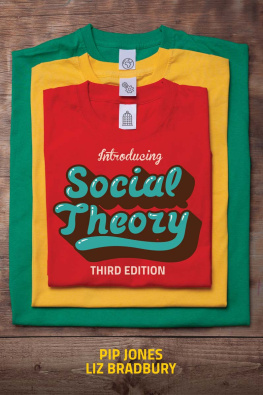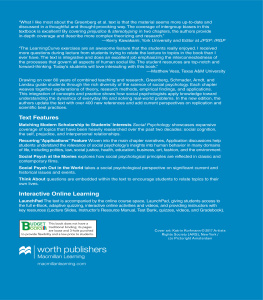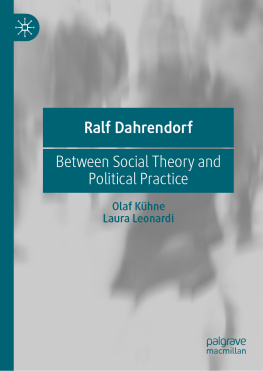Social Psychology Series
John Harvey, Series Editor
Empathy: A Social Psychological Approach, Mark H. Davis
Violence Within the Family: Social Psychological Perspectives,
Sharon D. Herzberger
Social Dilemmas, Samuel S. Komorita and Craig D. Parks
Self-Presentation: Impression Management
and Interpersonal Behavior, Mark R. Leary
Experimental and Nonexperimental Designs in Social
Psychology, Abraham S. Ross and Malcolm Grant
Intergroup Relations, Walter G. Stephan and Cookie White Stephan
First published 1996 by Westview Press
Published 2018 by Routledge
52 Vanderbilt Avenue, New York, NY 10017, USA
2 Park Square, Milton Park, Abingdon, Oxon OX14 4RN
Routledge is an imprint of the Taylor & Francis Group, an informa business
Copyright 1994,1996 Taylor & Francis
All rights reserved. No part of this book may be reprinted or reproduced or utilised in any form or by any electronic, mechanical, or other means, now known or hereafter invented, including photocopying and recording, or in any information storage or retrieval system, without permission in writing from the publishers.
Notice:
Product or corporate names may be trademarks or registered trademarks, and are used only for identification and explanation without intent to infringe.
Komorita, Samuel S.
Social dilemmas / by Samuel S. Komorita, Craig P. [sic] Parks.
p. cm.
Originally published: Madison, Wis. : Brown & Benchmark, c1994.
Includes bibliographical references and index.
ISBN 0-8133-3003-3 (pbk.)
1. Social conflict. 2. Social problems. 3. Social psychology.
I. Parks, Craig D. II. Title.
HM136.K716 1996
303.6dc20 96-463
CIP
ISBN 13: 978-0-8133-3003-7 (pbk)
A social dilemma is that rare topic in psychology that appeals not only to psychologists, but also to researchers in many other disciplines: economists, sociologists, political scientists, and biologists all have done extensive work on the topic. Besides its broad appeal, the popularity of social dilemma research is growing rapidly. During the four-year period from 1976 to 1980, a total of 6 psychological (behavioral) studies of social dilemmas were published; from 1981 to 1985, 33 were published; and from 1986 to 1990, 51 were published.
Our purpose in writing this book is to provide a summary and integration of the psychological research, and to introduce readers to some of the work being done in other disciplines. The question that occupies most psychologists working in this area is, How can we encourage people to be more cooperative? This is the basic theme of our book and we shall attempt to answer this question for a variety of social dilemma situations.
Research on social dilemmas is also important because they are so pervasive. Throughout the book, we shall give many realworld examples of social dilemma situations. Social psychology is sometimes criticized for studying abstract questions that have little relevance to society. By contrast, many of the findings we shall report (derived from laboratory experimentation) are directly adaptable to real-life dilemmas. This is not to say that the techniques designed to improve cooperation (discussed in this book) can be easily implemented in the real world; however, it would certainly be possible to test some of them in an actual dilemma setting. The study of social dilemmas thus has ecological as well as theoretical relevance.
The first portion of the book ( describes political science, economic, and biological approaches to the topic.
A project of this magnitude inevitably requires the help of others, and many individuals graciously offered their time and effort. Norbert Kerr and Scott Plous provided references and comments; members of the Social Dilemma Research Group (especially Lorne Hulbert) of the University of Illinois critiqued earlier versions of several chapters; and Jane Weber provided the clerical support necessary to pull all of the material together.
We would also like to thank those reviewers whose in-depth critiques directed us in completing the final version of this text: Scott Allison, University of Richmond; Charles Samuelson, Texas A & M University; and David Schroeder, University of Arkansas.
CHAPTER
1
Introduction
The Nature of Interdependence
Correspondence of Outcomes
The Mixed-Motive Case
Social Dilemmas
The Prisoners Dilemma
Social Traps
The Public Goods Paradigm
Take-Some and Give-Some Games
Summary and Conclusions
Notes
A pervasive feature of social interaction is the conflict between an individuals motive to maximize personal (selfish) interests and the motive to maximize collective interests. Yet, in many situations, if all attempt to maximize their selfish interests, all are worse than if all cooperate to maximize their collective interests. Such conflicts are of interest to a variety of social scientists and this book will examine theory and research on how people are likely to resolve such conflicts of motives.
There are many real-life examples of such conflicts. Consider two examples described by Dawes (1980).
People asked to keep their thermostats low to conserve energy are being asked to suffer from the cold without appreciably conserving the fuel supply by their individual sacrifices; yet if all keep their thermostats high, all may run out of fuel and freeze.
Women in India will almost certainly outlive their husbands, and for the vast majority who cant work, their only source of support in their old age is their male sons. Thus each individual woman achieves the highest social payoff by having as many children as possible. Yet the resulting overpopulation makes a social security or old-age benefit system impossible, so that all the women are worse off than they would have been if they had all practiced restraint in having children (p. 171).
To demonstrate how frequently such conflicts occur, consider the following examples:
In Los Angeles, residents are asked to help reduce air pollution by car-pooling, using public transportation, bicycling, or walking, instead of driving a car. For many people, such measures are an inconvenience, and any single persons ability to affect air quality is negligible. Yet if no one does this, all residents will breathe dirty air.
Every Labor Day weekend, the Muscular Dystrophy Association holds its annual telethon to raise money. Since it is highly unlikely that any one person will ever need the charitys services, that person will be giving money for a service he/she will probably never use. If no one sends money, though, the charity cannot survive, and society will have in its midst a deadly affliction that is not being fought.
We could list many more examples, but these should be sufficient to illustrate our point:











